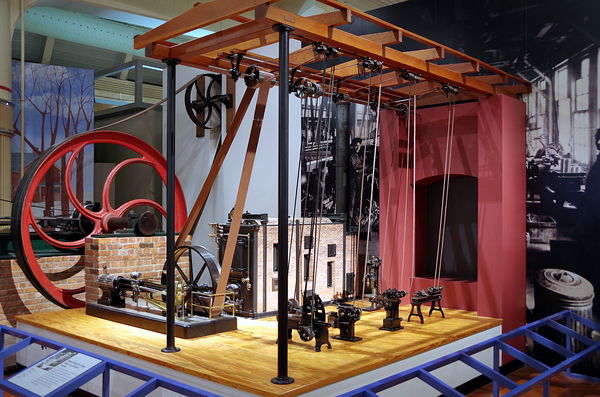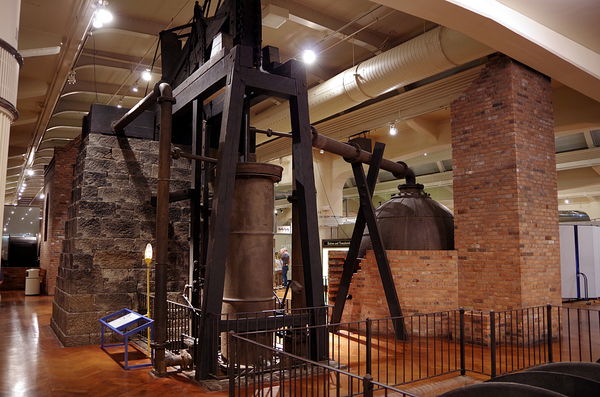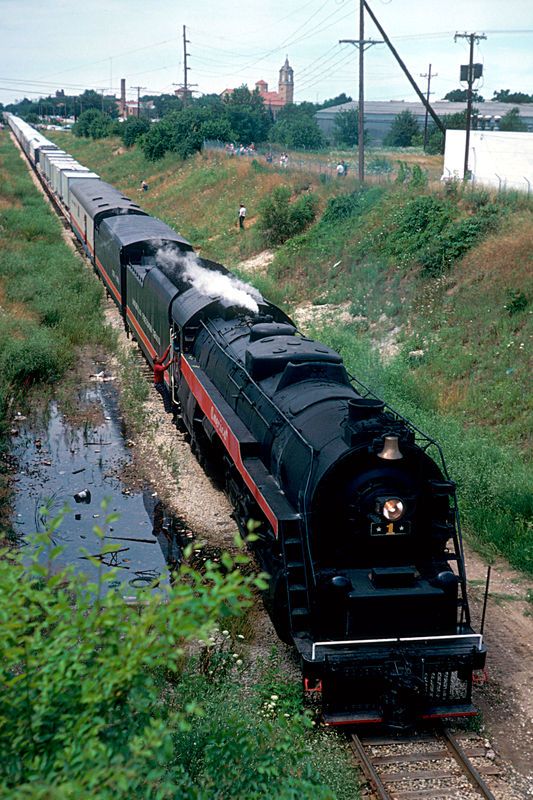Old Steam Engine
Sep 8, 2015 19:43:15 #
Technically speaking, a "steam engine" is the part of a "steam locomotive" that provides power; they were originally developed to pump water out of coal mines, and as engineers figured out how to make the parts smaller they were applied to transportation.
They were also used in the early days of the industrial revolution to power factories (before electric motors), using a series of pulleys to power machines. A few days ago, Jay Pat posted pictures of an old railroad machine shop that was powered in that way http://www.uglyhedgehog.com/t-334918-1.html. This past weekend, my family visited the Henry Ford Museum in Dearborn MI, and with the discussion resulting from Jay Pat's pictures in my mind, I was especially interested in the displays concerning the early use of steam.
The first picture here is a model of how a machine shop, like the one Jay Pat saw, worked (the big red wheel on the far left is part of a different display). The machine shop taking power off the overhead system is on the right, the "steam engine" which turns steam into power on the overhead system is on the left, and the boiler to produce steam is in the middle.
The second picture here is an early steam pump, functionally like the sump pump in my basement, built to move water out of an English coal mine. I don't remember which one this is; all the ones there were built around 1760; one of them was used until the 1920's.
They were also used in the early days of the industrial revolution to power factories (before electric motors), using a series of pulleys to power machines. A few days ago, Jay Pat posted pictures of an old railroad machine shop that was powered in that way http://www.uglyhedgehog.com/t-334918-1.html. This past weekend, my family visited the Henry Ford Museum in Dearborn MI, and with the discussion resulting from Jay Pat's pictures in my mind, I was especially interested in the displays concerning the early use of steam.
The first picture here is a model of how a machine shop, like the one Jay Pat saw, worked (the big red wheel on the far left is part of a different display). The machine shop taking power off the overhead system is on the right, the "steam engine" which turns steam into power on the overhead system is on the left, and the boiler to produce steam is in the middle.
The second picture here is an early steam pump, functionally like the sump pump in my basement, built to move water out of an English coal mine. I don't remember which one this is; all the ones there were built around 1760; one of them was used until the 1920's.
Sep 8, 2015 20:00:41 #
Sep 8, 2015 20:30:49 #
Sep 8, 2015 21:41:00 #
In the very early days of steam engines it took almost as much water as coal to produce locomotion. That's because the steam was vented out of the steam stack (whistle tower) and not recovered. It was only when they figured out a way to re-use the water (like Navy ships used to do) that boilers became semi-efficient in their use of natural resources. I know. I was a Chief Engineer on several steam-powered naval vessels.
Sep 8, 2015 21:54:26 #
Sep 9, 2015 06:20:23 #
alawry
Loc: Timaru New Zealand
Fascinating that while steam engines are an early engine, remember that Nuclear power plants are really only glorified steam engines. Boiling the water with nuclear power then using the steam to generate power. So I believe. Stand to be corrected. Turbine rather than pistons but expanding steam never the less.
Sep 9, 2015 07:16:00 #
alawry wrote:
You're exactly correct. The steam is then converted into water in a condenser where it gives up heat and creates a vacuum, which in turn accelerates the motive force of the steam as it passes through the turbines.Fascinating that while steam engines are an early engine, remember that Nuclear power plants are really only glorified steam engines. Boiling the water with nuclear power then using the steam to generate power. So I believe. Stand to be corrected. Turbine rather than pistons but expanding steam never the less.
Sep 9, 2015 07:23:07 #
alawry
Loc: Timaru New Zealand
Thanks for the affirmation Bob. Cheers, Andrew.
Bob Yankle wrote:
You're exactly correct. The steam is then converted into water in a condenser where it gives up heat and creates a vacuum, which in turn accelerates the motive force of the steam as it passes through the turbines.
Sep 9, 2015 08:19:04 #
rehess wrote:
Technically speaking, a "steam engine" i... (show quote)
rehess, awesome pictures, good detail and composition, and good image quality. Thanks for sharing both the pictures and story. :thumbup: Tejaswrangler :)
Sep 9, 2015 08:38:56 #
Sep 9, 2015 08:44:22 #
Bob Yankle wrote:
And in the early daze they could tolerate this loss, mainly because they didn't have any options. If you watch an old steam locomotive run, even a well-maintained one, you can see steam leave the pistons at every stroke.In the very early days of steam engines it took almost as much water as coal to produce locomotion. That's because the steam was vented out of the steam stack (whistle tower) and not recovered. It was only when they figured out a way to re-use the water (like Navy ships used to do) that boilers became semi-efficient in their use of natural resources. I know. I was a Chief Engineer on several steam-powered naval vessels.
The sign at the "sump pump" that was used until 1926 says that they continued to run it despite its inefficiency because it ran on waste coal from the mine; they didn't say where the water came from - presumably they didn't just filter the water they had just pumped out of the mine (I would expect that to be way too hard, but you never know).
The Cumbres & Toltec tourist railroad makes at least one water stop that I know of in its 60 mile run from Chama NM to Antonito CO. When they run a special photo charter, I hear they sometimes have to set out a tank car of water along the way, because they spend extra time posing for pictures.
If you drive across Nevada on I-80, you'll notice a small town every so often along the road; my understanding is that they started off as watering stops for the railroad.
Sep 9, 2015 08:48:03 #
tejaswrangler wrote:
Thank you. My wife is used to a "five-minute" photo stop stretching out to thirty minutes or more as I look for the picture I had in my mind before I took my camera out.rehess, awesome pictures, good detail and composition, and good image quality. Thanks for sharing both the pictures and story. :thumbup: Tejaswrangler :)
Sep 9, 2015 09:19:47 #
alawry wrote:
Fascinating that while steam engines are an early engine, remember that Nuclear power plants are really only glorified steam engines. Boiling the water with nuclear power then using the steam to generate power. So I believe. Stand to be corrected. Turbine rather than pistons but expanding steam never the less.
Bob Yankle wrote:
You're exactly correct. The steam is then converted into water in a condenser where it gives up heat and creates a vacuum, which in turn accelerates the motive force of the steam as it passes through the turbines.
I never knew this about turbine engines.
Pat
Sep 9, 2015 09:43:19 #
Enjoyed the views of the early steam power equipment. My father was a marine engineer and I did get to see him in action running a steam powered ferry. Here are two views of where the throttle and engine telegraph were located in the engine room.
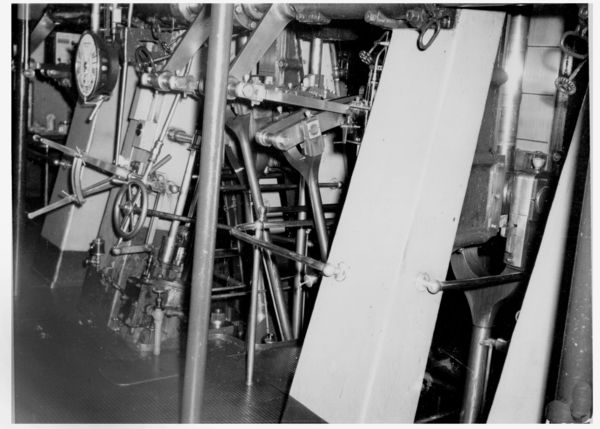
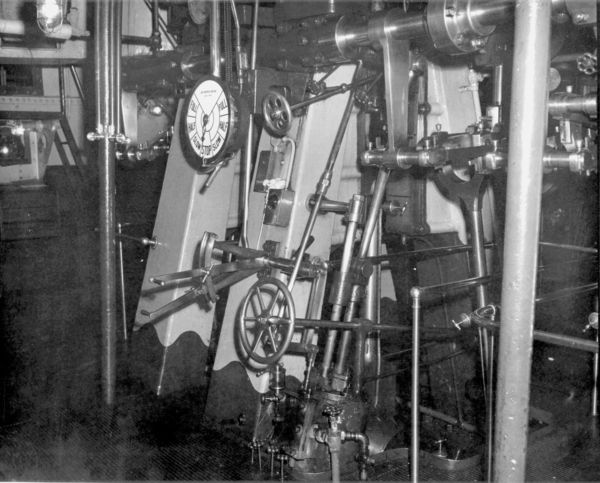
Sep 9, 2015 11:12:48 #
Bob Yankle wrote:
In the very early days of steam engines it took almost as much water as coal to produce locomotion. That's because the steam was vented out of the steam stack (whistle tower) and not recovered. It was only when they figured out a way to re-use the water (like Navy ships used to do) that boilers became semi-efficient in their use of natural resources. I know. I was a Chief Engineer on several steam-powered naval vessels.
rehess wrote:
Mainline steam excursions often use an auxiliary tender, located behind the standard tender, to supplement their water-carrying capacity, so they don't have to stop as often. In this scan of a Kodachrome 25 slide I took in 1975 of the American Freedom Train, you can see there is an extra tender behind the regular one.If you watch an old steam locomotive run, even a w... (show quote)
If you want to reply, then register here. Registration is free and your account is created instantly, so you can post right away.

